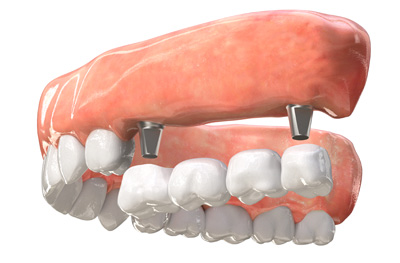
When multiple teeth are missing or failing, treatment options may include:
- A removable partial denture
- A multiple tooth supported fixed bridge
- An implant-supported bridge
A removable partial denture utilizes clasps that grab onto adjacent, healthy teeth to hold the denture in place. The clasps, which are designed to fit snugly onto the healthy teeth put pressure on the underlying gums and natural teeth they hook onto. This weakens the jawbone and loosens the supporting teeth, which often leads to additional tooth loss. In addition, because there is no root system for the missing teeth, the integrity of the jawbone is compromised, and the melting away of the bone (atrophy) is actually accelerated, resulting in more rapid bone deterioration.
A multiple tooth-supported fixed bridge is a conventional tooth replacement option and has all the complications, compromises and risks of a single tooth bridge, only to a much greater degree. Problems of decay, root canal infections, periodontal bone loss and bone atrophy can be worse simply because there are more teeth involved. Unfortunately, larger bridges fail faster than single tooth bridges.

An implant-supported bridge is far superior to removable partials or multiple tooth supported fixed bridges:
- Dental implants virtually stop the bone resorption process (deterioration)
- Implants are much more comfortable and stable than partial dentures
- The integrity of the facial structure is maintained (no sagging jaw line)
- The gum line stays intact ÔÇô not eaten away by metal clasps
- Natural biting and chewing capacity is restored
- Adjacent natural teeth are preserved
- You can eat what you want, when you want, where you want ÔÇô steak, corn on the cob, apples, crunchy snacks, sticky snacks
- Dental implants look, act, and feel just like natural teeth
- Dental implants are permanent ÔÇô no need to deal with messy adhesives or cleaning solutions
